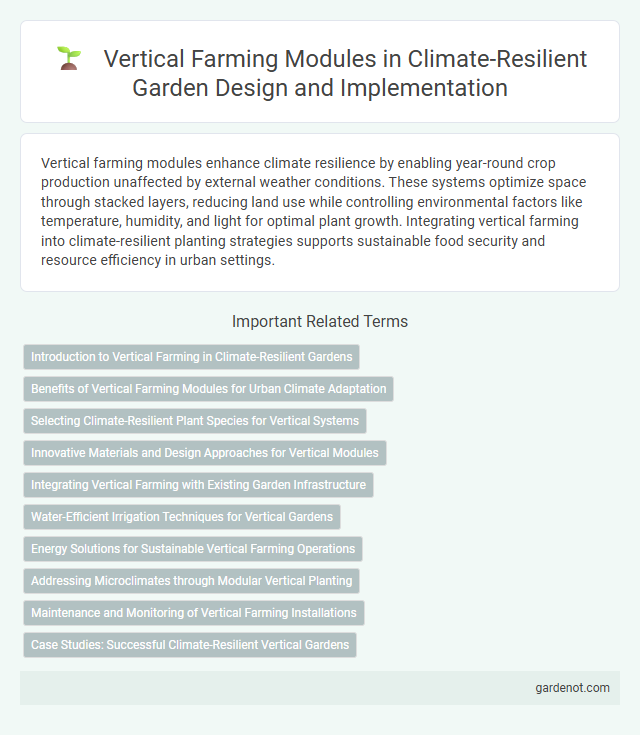Vertical farming modules enhance climate resilience by enabling year-round crop production unaffected by external weather conditions. These systems optimize space through stacked layers, reducing land use while controlling environmental factors like temperature, humidity, and light for optimal plant growth. Integrating vertical farming into climate-resilient planting strategies supports sustainable food security and resource efficiency in urban settings.
Introduction to Vertical Farming in Climate-Resilient Gardens
Vertical farming integrates soil-less cultivation techniques such as hydroponics and aeroponics in climate-resilient gardens, optimizing space and resource efficiency. This innovative module enhances yield stability by reducing dependency on traditional arable land and mitigating the impacts of extreme weather conditions. Controlled environment agriculture within vertical farms allows precise management of temperature, humidity, and light, significantly improving crop resilience against climate variability.
Benefits of Vertical Farming Modules for Urban Climate Adaptation
Vertical farming modules enhance urban climate adaptation by enabling efficient use of limited space through stacked, controlled-environment agriculture that reduces water usage by up to 90% compared to traditional farming. These systems improve local food security and minimize carbon footprints by decreasing the need for long-distance transportation. Advanced vertical farms also mitigate urban heat island effects by integrating greenery into cityscapes, contributing to cooler microclimates and reduced energy consumption for cooling.
Selecting Climate-Resilient Plant Species for Vertical Systems
Selecting climate-resilient plant species for vertical farming modules enhances productivity by optimizing growth conditions in controlled environments. Species such as leafy greens, herbs, and microgreens demonstrate high tolerance to fluctuating temperatures, humidity, and limited space typical of vertical systems. Integrating drought-resistant and pest-resistant varieties further reduces resource use and improves crop resilience against climate variability.
Innovative Materials and Design Approaches for Vertical Modules
Vertical farming modules utilize innovative materials such as lightweight, UV-resistant composites and transparent biodegradable polymers to enhance durability and light penetration. Design approaches incorporate modular, stackable structures with integrated LED lighting systems and automated climate controls, optimizing space efficiency and crop yield. These advancements enable precise environmental management and resource conservation, critical for climate-resilient urban agriculture.
Integrating Vertical Farming with Existing Garden Infrastructure
Integrating vertical farming modules with existing garden infrastructure maximizes space efficiency and enhances crop yield by utilizing vertical layers for cultivation. This approach incorporates hydroponic or aeroponic systems, ensuring optimized water use and nutrient delivery while reducing environmental impact. Combining traditional soil-based gardening with vertical farming creates a resilient, diversified food production system adaptable to changing climate conditions.
Water-Efficient Irrigation Techniques for Vertical Gardens
Vertical farming modules integrate advanced water-efficient irrigation techniques such as drip irrigation and nutrient film systems to minimize water use in vertical gardens. These methods deliver precise amounts of water directly to plant roots, reducing evaporation and runoff while enhancing crop yield and growth rates. Implementing sensor-based irrigation controls further optimizes water consumption by adjusting supply according to real-time moisture levels, promoting climate resilience in urban agriculture.
Energy Solutions for Sustainable Vertical Farming Operations
Energy-efficient LED lighting systems significantly reduce power consumption in sustainable vertical farming operations, optimizing photosynthesis while minimizing carbon footprint. Integration of renewable energy sources such as solar panels and wind turbines further enhances energy autonomy and reduces dependency on the grid. Advanced energy management systems enable real-time monitoring and adaptive control, maximizing energy savings and ensuring consistent crop yield under climate-resilient conditions.
Addressing Microclimates through Modular Vertical Planting
Modular vertical planting in vertical farming systems enables precise control of microclimates by optimizing light, humidity, and temperature conditions for diverse crops within compact spaces. This approach enhances climate resilience by tailoring environmental parameters to specific plant needs, reducing resource consumption and mitigating exposure to external climate variability. Integrating advanced sensors and automated controls further supports adaptive management, ensuring consistent growth and improved yield stability in urban agricultural settings.
Maintenance and Monitoring of Vertical Farming Installations
Maintenance and monitoring of vertical farming installations involve regular inspection of environmental controls, such as humidity, temperature, and light levels, to ensure optimal plant growth in climate-resilient systems. Advanced sensor technology and automated data collection enable precise adjustments and early detection of pests or diseases, reducing crop loss. Continuous system calibration and nutrient management maintain plant health and maximize yield efficiency in vertical farming operations.
Case Studies: Successful Climate-Resilient Vertical Gardens
Vertical farming modules demonstrate significant potential in climate-resilient planting by optimizing space and resource use in urban environments. Case studies from Singapore's Sky Greens and the Netherlands' PlantLab reveal substantial yield increases and water savings of up to 90% compared to traditional agriculture. These vertical gardens also contribute to reducing urban heat islands and lowering carbon footprints through localized food production.
Vertical farming module Infographic

 gardenot.com
gardenot.com